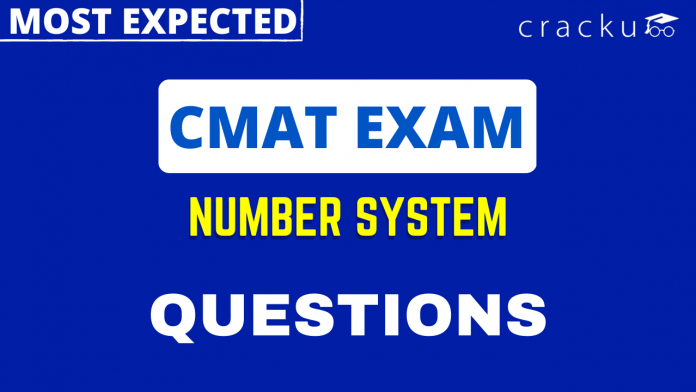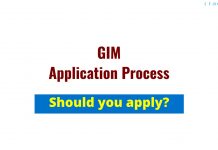CMAT Number System Questions [Download PDF]
Download Number System Questions for CMAT PDF – CMAT Number System questions PDF by Cracku. Practice CMAT solved Number System Questions paper tests, and these are the practice question to have a firm grasp on the Number System topic in the XAT exam. Top 20 very Important Number System Questions for XAT based on asked questions in previous exam papers. Click on the link below to download the Number System Questions for CMAT PDF with detailed solutions.
Download Number System Questions for CMAT
Enroll to CMAT 2023 Crash Course
Question 1: Consider the expression $(xxx)_{b}=x^3$, where b is the base, and x is any digit of base b. Find the value of b:
a) 5
b) 6
c) 7
d) 8
e) None of the above
1) Answer (E)
Solution:
$(xxx)_{b}=x^3$
=> $xb^2+xb+x = x^3$
=> $b^2+b+1=x^2$
On substituting b=1,and b=2, we get $x^2$ as $3$, and $7$. Since $3$ and $7$ are not perfect squares, we can infer that no number satisfies the given condition. Therefore, option E is the right answer.
Question 2: Please read the following sentences carefully:
I — 103 and 7 are the only prime factors of 1000027
II — $\sqrt[6]{6!}>\sqrt[7]{7!}$
III — If I travel one half of my journey at an average speed of x km/h, it will be impossible for me to attain an average speed of 2x km/h for the entire journey.
a) All the statements are correct
b) Only Statement Il is correct
c) Only Statement Ill is correct
d) Both statements I and Il are correct
e) Both statements I and Ill are correct
2) Answer (C)
Solution:
Let us evaluate the statements one by one:
I: 103 and 7 are the only prime factors of 1000027
On successively dividing 1000027 by 103 and 7, we get 1387 as the answer.
1387 is divisible by 19.
Therefore, statement I is false.
II: $\sqrt[6]{6!}>\sqrt[7]{7!}$
Raising the power to 42 on both sides, we get,
$[6!]^7>[7!]^6$
$6!*[6!]^6 > 7^6*[6!]^6$
$7^6$ is greater than $6!$.
Therefore, statement II is false.
III:It has been given that the person travels one-half of the journey at x kmph.
Let us assume the distance to be ‘2d’.
Let us assume the average speed to be 2d and check for the feasibility.
Let the speed at which the person travels the other half of the journey be y.
d/x + d/y = 2d/2x
d/x + d/y = d/x
=> d/y = 0 or y tends to infinity.
Therefore, such a scenario is not possible and hence, statement III is true.
Only statement III is true. Therefore, option C is the right answer.
Question 3: Find the value of the expression: $10 + 10^3 + 10^6 + 10^9$
a) 1010101010
b) 1001000010
c) 1001000110
d) 1001001010
e) 100010001010
3) Answer (D)
Solution:
$10 + 10^3 + 10^6 + 10^9 = 10 + 1000 + 1000000 + 1000000000$
=$1001001010$
Therefore, option D is the right answer.
Question 4: An antique store has a collection of eight clocks. At a particular moment, the displayed times on seven of the eight clocks were as follows: 1:55 pm, 2:03 pm, 2:11 pm, 2:24 pm, 2:45 pm, 3:19 pm and 4:14 pm. If the displayed times of all eight clocks form a mathematical series, then what was the displayed time on the remaining clock?
a) 1:53 pm
b) 1:58 pm
c) 2:18 pm
d) 3:08 pm
e) 5:08 pm
4) Answer (B)
Solution:
Let us find out the difference between the times given to figure out the pattern.
The times given are 1:55 pm, 2:03 pm, 2:11 pm, 2:24 pm, 2:45 pm, 3:19 pm and 4:14 pm.
The difference between 2 consecutive times given are 8 minutes, 8 minutes, 13 minutes, 21 minutes, 34 minutes, and 55 minutes.
We can observe that the difference between the times are in the Fibonacci series.
8 + 13 = 21
21 + 13 = 34
34 + 21 = 55
The Fibonacci series is as follows:
1,1,2,3,5,8,13,21,34,55.
But the first difference in the times given is 8.
Therefore, the missing time must be such that it divides the interval of 8 minutes into 3 minutes and 5 minutes.
The missing time should be 1:58 pm and hence, option B is the right answer.
Question 5: X and Y are the digits at the unit’s place of the numbers (408X) and (789Y) where X ≠ Y. However, the digits at the unit’s place of the numbers $(408X)^{63}$ and $(789Y)^{85}$ are the same. What will be the possible value(s) of (X + Y)?
a) 9
b) 10
c) 11
d) 12
e) None of the above
5) Answer (B)
Solution:
All numbers from 1 to 9 repeat their last digits over a cycle of 4.
63 can be written as 4k+3.
85 can be written as 4k+1.
Some number’s third power should yield the first digit as some number’s first power.
$2^3$ will yield $8$ as the last digit (2 and 8 is a possible solution).X+Y = 10
$3^3$ will yield $7$ as the last digit (3 and 7 is a possible solution).X + Y = 10
$4^3$ will yield $4$ as the last digit and hence, can be eliminated.
$5$ and $6$ yield $5$ and $6$ respectively as the last digit for any power and hence, can be eliminated.
$7^3$ will yield $3$ as the last digit (7 and 3 is a possible solution). X+Y=10.
$8^3$ will yield $2$ as the last digit. 8+2 =10.
As we can see, X+Y = 10 in all the cases. Therefore, option B is the right answer.
Question 6: David has an interesting habit of spending money. He spends exactly £X on the Xth day of a month. For example, he spends exactly £5 on the 5th of any month. On a few days in a year, David noticed that his cumulative spending during the last ‘four consecutive days’ can be expressed as $2^N$ where N is a natural number. What can be the possible value(s) of N?
a) 5
b) 6
c) 7
d) 8
e) N can have more than one value
6) Answer (B)
Solution:
The sum of 4 consecutive numbers should be a power of 2.
The powers of 2 are 1, 2, 4, 8, 16, 32, 64, 128. The maximum possible value that 4 consecutive days can take is 28 + 29 + 30 + 31 = 118.
We can eliminate 1, 2, 4, and 8 since sum of 4 consecutive integers is always greater than 9.
Let the first day be x.
x+x+1+x+2+x+3 = 16
=> 4x = 10
x = 2.5
We can eliminate 16.
Let us check for 32.
x+x+1+x+2+x+3 = 32
4x = 26.
x is not an integer.
Let us check the case in which x is the last day of the month.
Even in the month of February, the least value that x can take is 28.
28+1+2+3 = 34 > 32.
We can eliminate 32 as well.
Let us check for 64.
4x+6 = 64
4x = 58
The sum of no 4 consecutive days in the same month can be expressed as 4k+6.
Let us check the cases in which 2 months are involved.
29+30+1+2 = 62 < 64.
30 + 31 + 1 + 2 = 64. This is a possible combination.
There are 7 months with 31 days in a year. We have to eliminate December since 1 will spill over to the 1st of January of the next year.
Therefore, in a year, there will be 6 such instances. Therefore, option B is the right answer.
Question 7: While multiplying three real numbers, Ashok took one of the numbers as 73 instead of 37. As a result, the product went up by 720. Then the minimum possible value of the sum of squares of the other two numbers is
7) Answer: 40
Solution:
We know that one of the 3 numbers is 37.
Let the product of the other 2 numbers be x.
It has been given that 73x-37x = 720
36x = 720
x = 20
Product of 2 real numbers is 20.
We have to find the minimum possible value of the sum of the squares of the 2 numbers.
Let x=a*b
It has been given that a*b=20
The least possible sum for a given product is obtained when the numbers are as close to each other as possible.
Therefore, when a=b, the value of a and b will be $\sqrt{20}$.
Sum of the squares of the 2 numbers = 20 + 20 = 40.
Therefore, 40 is the correct answer.
Question 8: The number of integers x such that $0.25 \leq 2^x \leq 200$ and $2^x + 2$ is perfectly divisible by either 3 or 4, is
8) Answer: 5
Solution:
At $x = 0, 2^x = 1$ which is in the given range [0.25, 200]
$2^x + 2$ = 1 + 2 = 3 Which is divisible by 3. Hence, x = 0 is one possible solution.
At $x = 1, 2^x = 2$ which is in the given range [0.25, 200]
$2^x + 2$ = 2 + 2 = 3 Which is divisible by 4. Hence, x = 1 is one possible solution.
At $x = 2, 2^x = 4$ which is in the given range [0.25, 200]
$2^x + 2$ = 4 + 2 = 6 Which is divisible by 3. Hence, x = 2 is one possible solution.
At $x = 3, 2^x = 8$ which is in the given range [0.25, 200]
$2^x + 2$ = 8 + 2 = 3 Which is not divisible by 3 or 4. Hence, x = 3 can’t be a solution.
At $x = 4, 2^x = 16$ which is in the given range [0.25, 200]
$2^x + 2$ = 16 + 2 = 18 Which is divisible by 3. Hence, x = 4 is one possible solution.
At $x = 5, 2^x = 32$ which is in the given range [0.25, 200]
$2^x + 2$ = 32 + 2 = 34 Which is not divisible by 3 or 4. Hence, x = 5 can’t be a solution.
At $x = 6, 2^x = 64$ which is in the given range [0.25, 200]
$2^x + 2$ = 64 + 2 = 66 Which is divisible by 3. Hence, x = 6 is one possible solution.
At $x = 7, 2^x = 128$ which is in the given range [0.25, 200]
$2^x + 2$ = 128 + 2 = 130 Which is not divisible by 3 or 4. Hence, x = 7 can’t be a solution.
At $x = 8, 2^x = 256$ which is not in the given range [0.25, 200]. Hence, x can’t take any value greater than 7.
Therefore, all possible values of x = {0,1,2,4,6}. Hence, we can say that ‘x’ can take 5 different integer values.
Question 9: If the sum of squares of two numbers is 97, then which one of the following cannot be their product?
a) -32
b) 16
c) 48
d) 64
9) Answer (D)
Solution:
Let ‘a’ and ‘b’ are those two numbers.
$\Rightarrow$ $a^2+b^2 = 97$
$\Rightarrow$ $a^2+b^2-2ab = 97-2ab$
$\Rightarrow$ $(a-b)^2 = 97-2ab$
We know that $(a-b)^2$ $\geq$ 0
$\Rightarrow$ 97-2ab $\geq$ 0
$\Rightarrow$ ab $\leq$ 48.5
Hence, ab $\neq$ 64. Therefore, option D is the correct answer.
Question 10: The smallest integer n for which $4^{n} > 17^{19}$ holds, is closest to
a) 37
b) 35
c) 33
d) 39
10) Answer (D)
Solution:
$4^{n} > 17^{19}$
$\Rightarrow$ $16^{n/2} > 17^{19}$
Therefore, we can say that n/2 > 19
n > 38
Hence, option D is the correct answer.
Question 11: If $\sqrt[3]{7^a\times 35^{b+1} \times 20^{c+2}}$ is a whole number then which one of the statements below is consistent with it?
a) a = 2, b = 1, c = 1
b) a = 1, b = 2, c = 2
c) a = 2, b = 1, c = 2
d) a = 3, b = 1, c = 1
e) a = 3, b = 2, c = 1
11) Answer (E)
Solution:
In the given statement, the expression becomes a whole number only when the powers of all the prime numbers are also whole numbers.
Let us first simplify the expression a bit by expressing all terms in terms of prime numbers.
$\sqrt[3]{7^a\times 35^{b+1} \times 20^{c+2}}$
$\Rightarrow \sqrt[3]{7^a\times 5^{b+1} \times 7^{b+1} \times 2^{2(c+2)} \times 5^{c+2}}$
$\Rightarrow \sqrt[3]{2^{2c+4} \times 5^{b+c+3} \times 7^{a+b+1}}$
$\Rightarrow 2^{\frac{2c+4}{3}} 5^{\frac{b+c+3}{3}} 7^{\frac{a+b+1}{3}} $
Now, from the given options, we can put in values of the variables and check the exponents of all the numbers.
Option A : a = 2, b = 1, c = 1 :
In this case, we can see that exponent of 5 ie $\frac{b+c+3}{3} = \frac{5}{3} $ is not a whole number.
Option B : a = 1, b = 2, c = 2
In this case, we can see that exponent of 2 ie $\frac{2c+4}{3} = \frac{8}{3} $ is not a whole number.
Option C : a = 2, b = 1, c = 2
In this case, we can see that exponent of 2 ie $\frac{2c+4}{3} = \frac{8}{3} $ is not a whole number.
Option D : a = 3, b = 1, c = 1
In this case, we can see that exponent of 5 ie $\frac{b+c+3}{3} = \frac{5}{3} $ is not a whole number.
Option E : a = 3, b = 2, c = 1
In this case, we can see that all exponents are whole numbers.
Thus, option E is the correct option.
Question 12: The following table lists the marks of seven students(rows) of a class across six subjects(columns). The Numbers in the Parenthesis indicate the maximum marks of the subject concerned. Use the data in the table to answer the question that follows :

Who is the topper of the class?
a) Maya
b) Arya
c) Roopesh
d) Riya
12) Answer (B)
Solution:
The topper of the class is the one who gets a highest overall score. Let us check the options, who has got the overall score.
Option A:
The overall score of Maya = 90 + 50 + 90 + 60 + 70 + 80 = 440 marks
Option B:
The overall score of Arya = 100 + 80 + 88 + 60 + 80 + 70 = 478 marks
Option C:
The overall score of Rupesh = 80 + 55 + 85 + 95 + 50 + 90 = 455 marks
Option D:
The overall score of Riya = 90 + 72 + 70 + 72 + 91 + 70 = 465 marks
So, the topper of the class is Arya, with a overall score of 478 marks.
Question 13: What value should come in place of question mark(?) in the following equation?
$360\sqrt?$ + 4500 = 19700 – 9800
a) 395
b) 295
c) 225
d) 215
13) Answer (C)
Solution:
$360\sqrt?$ + 4500 = 19700 – 9800
$\Rightarrow 360\sqrt? + 4500 = 9900$
$\Rightarrow 360\sqrt? = 5400$
$\Rightarrow \sqrt? = 15$
$\Rightarrow ? = 15^2$
$\Rightarrow ? = 225$
Question 14: If one third of one-fourth of a number is 15, then three-tenth of that number is
a) 61
b) 54
c) 46
d) 38
14) Answer (B)
Solution:
Let the number be ‘x’
one-fourth of the number = $\frac{1}{4}\times x = \frac{x}{4}$
one-third of one-fourth of the number = $\frac{1}{3}\times \frac{x}{4} = \frac{x}{12}$
Given, one-third of one-fourth of the number is = 15
$\Rightarrow \frac{x}{12} = 15$
$\Rightarrow x = 180$
Hence the number is 180.
Then three-tenth of the number = $\frac{3}{10}\times x = \frac{3}{10}\times 180 = 54$
Question 15: $\sqrt{188+ \sqrt{51+ \sqrt{169}}}$ = ?
a) 16.4
b) 14.4
c) 16
d) 14
15) Answer (D)
Solution:
$\sqrt{188+ \sqrt{51+ \sqrt{169}}}$ = $\sqrt{188+ \sqrt{51+13}}$ = $\sqrt{188+ \sqrt{64}}$ = $\sqrt{188+ 8}$ = $\sqrt{196}$ = 14
Question 16: The number of integers between 300 and 1100 which are divisible by either 7 or 13 but not both is
a) 149
b) 158
c) 167
d) 176
16) Answer (B)
Solution:
Multiples of 7 are {301,308 …………………………..1099} n=115
Multiples of 13 are {312,323,……………………………1092} n = 61
Multiples of 91 are {364,455……………………………1092} n= 9
Number of integers which are divisible by either 7 or 13 but not both is 115+61-2*9
=158
Hence B is the correct answer.
Question 17: What is the average of the first 7 prime numbers?
a) 10.71
b) 6
c) 8.28
d) 8.58
17) Answer (C)
Solution:
Sum of first 7 prime numbers = 2 + 3 + 5 + 7 + 11 + 13 + 17 = 58
=> Average = $\frac{58}{7}=8.28$
=> Ans – (C)
Question 18: X is a number such that 65% of X is more than its 36% by 2900. What is 122% of the number X?
a) 10000
b) 11000
c) 13420
d) 12200
18) Answer (D)
Solution:
According to ques,
=> $(\frac{65}{100}\times X)-(\frac{36}{100}\times X)=2900$
=> $\frac{29X}{100}=2900$
=> $X=10000$
$\therefore$ 122% of X = $\frac{122}{100}\times10000=12200$
=> Ans – (D)
Question 19: The least number which is a perfect square and is divisible by each of the numbers 14, 16, 18 is
a) 6048
b) 7056
c) 1008
d) 2046
19) Answer (B)
Solution:
The least number that is divisible by 14,16,18 will be the LCM of three which is 1008 but it is not a perfect square .
$1008=2^4\cdot3^2\cdot7^{ }$ To make it a perfect square you need to multiply it by 7.
1008*7=7056
Question 20: Four people clap after every 20 minutes, 30 minutes, 40 minutes and 50 minutes respectively. All of them clapped together at 10.00 am. Then they will again clap together at ________
a) 3 pm
b) 5 pm
c) 6 pm
d) 8 pm
20) Answer (D)
Solution:
All of them will clap together after LCM(20,30,40,50) minutes = 600 minutes=10hrs
Therefore they will clap together again at 8pm.





